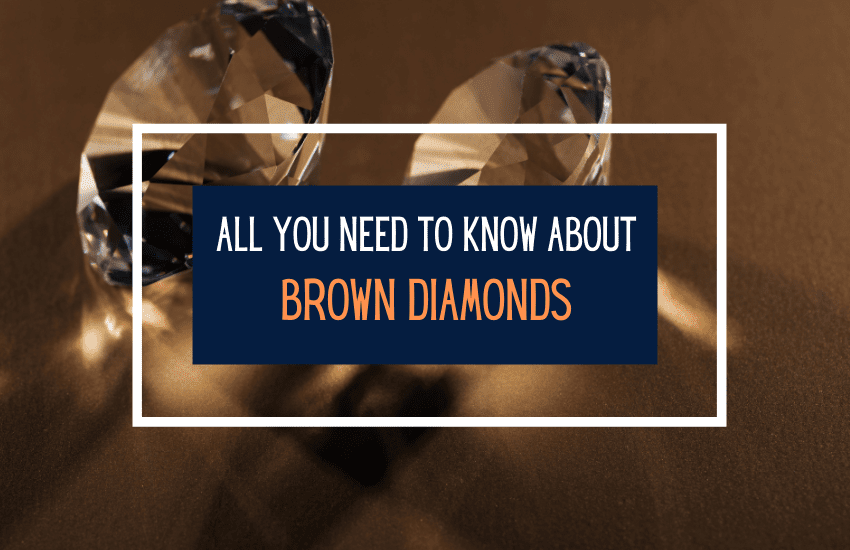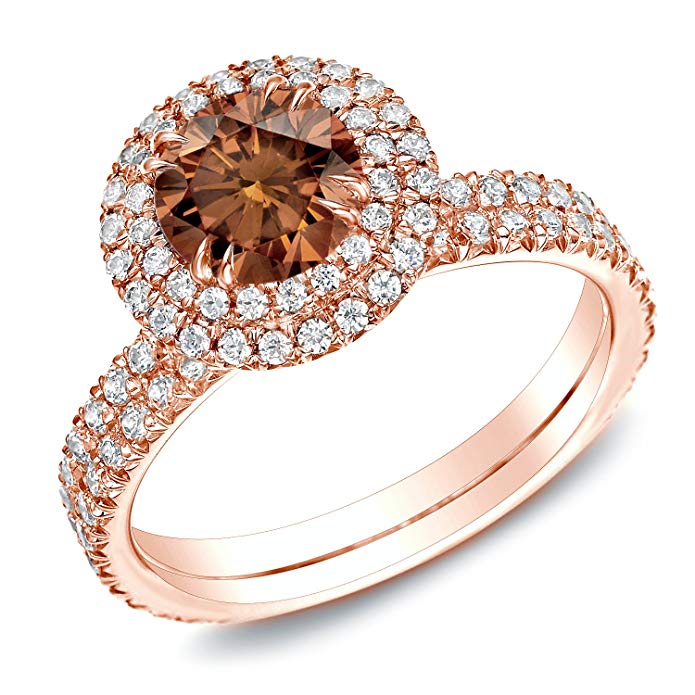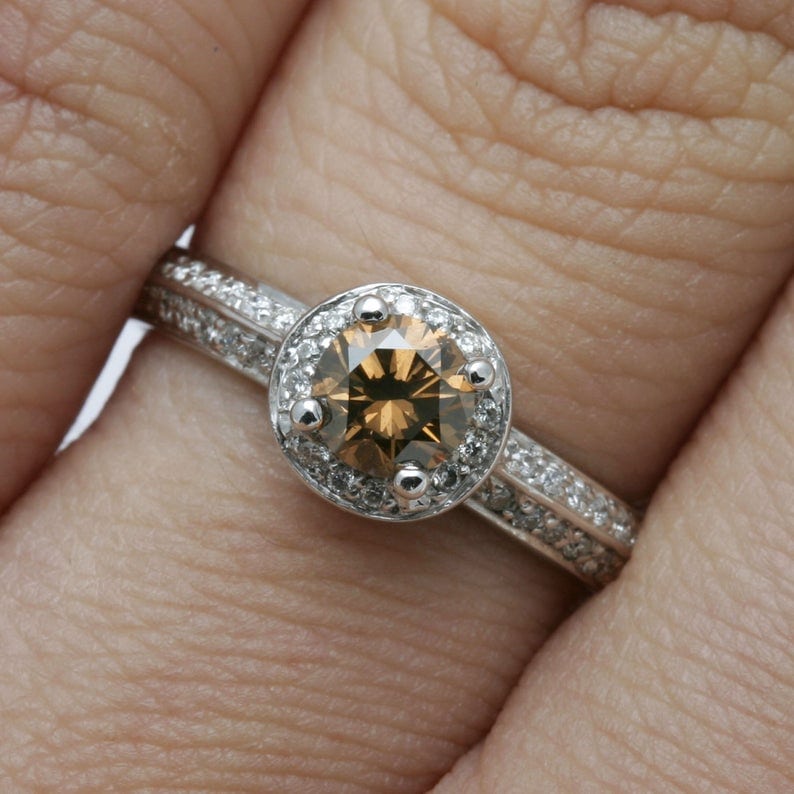
Table of Contents
You might have heard of champagne, cognac, or chocolate diamonds and wondered what variety of diamonds these were. In the jewelry world, these are all types of brown diamonds.
Brown diamonds have been escalating in popularity lately, due to positive marketing and because of high profile personalities flaunting them on the world stage.
If your heart is set on a colored diamond, but you don’t quite have the budget to splurge, then brown diamonds are an affordable and beautiful choice.
In this article, we’ll take a look at various types of brown diamonds on the market, as well as the factors you need to take into account when evaluating them.
How Are Brown Diamonds Formed?

Brown diamonds get their color from the presence of nitrogen during the formation of the stone. The more nitrogen present, the higher the saturation and the deeper the brownish color of the stone.
The creation process takes many millions of years. Most of the brown diamonds found in Australia are estimated to be over 3 billion years old!
Are Brown Diamonds Rare?
In the diamond world, brown diamonds are the most common variety and are relatively more affordable than other colored diamonds.
In fact, they are found in abundance in mines such as the Australian Argyle mine and, until recently, were mainly used for industrial purposes.
They can be difficult to cut and polish due to their crystalline structure but if done expertly, brown diamonds can hold their own against any other colored diamond.
What Are Champagne, Cognac, or Chocolate Diamonds?

These are all stones that come under the umbrella of brown diamonds. In the past, brown diamonds were not popular in the jewelry industry and were mainly used for industrial purposes.
Manufacturers needed some marketing strategies to heighten the allure of the stones. What better way than to attach names associated with elegance, class, and affluence to the brown stones?
The Argyle mine is credited for creating the successful marketing campaign that changed how people viewed these diamonds. They gave the brown stones the nickname ‘Champagne Diamonds’, which associates them with the elegance and class that the term champagne evokes. This clever strategy is partially responsible for the increased demand for brown diamonds.
While some have criticized this tactic as a means of hoodwinking buyers, on a practical note these terms do give a clear idea about the color of the stone.
1. Champagne Diamonds

This refers to brown diamonds that have a secondary yellowish tone – in other words, brown yellow stones. There are a range of colors in this category, such as faint yellow brown to fancy dark yellowish brown.
The prices vary for champagne diamonds. However, generally the most valuable are those that have a deeper color.
2. Cognac Diamonds

Cognac diamonds are on the darker end of the brown diamond color scale. They are strong in color, resembling the dark rich tones the drink cognac is famous for. They may also have a secondary tone of orange.
3. Chocolate Diamonds

This was a marketing term originated in 2000 by jewelry manufacturer Le Vian to attach value and elegance with dark brown diamonds.
As the name implies, chocolate diamonds have a much darker hue and are on the dark end of the brown diamond spectrum.
Brown Diamonds Engagement Rings
Brown diamonds are a nice change from colorless diamonds and make beautiful centerpieces for engagement rings.
From a color psychology aspect, brown symbolizes many positive things – reliability, elegance, healing, resilience, stability, honesty, and warmth. What better characteristics for a relationship that is about to embark on a new journey!
It is a solid and steady color, like the earth around us. For those of us who are nature lovers, a brown diamond can have that extra meaning too.
Deciding On Your Metal

When it comes to choosing the metal for your brown diamond engagement ring, you will have to consider the color of the diamond as well as your personal preference.
Generally, brown diamonds pair well with rose gold or yellow gold settings, as the contrast between the stone and the setting is not very high. The transition from stone to setting is smoother and easier on the eyes.

If you prefer a stronger statement and a bolder look, then white metals and brown diamonds will do that for you. The contrast is stronger, and your stone will stand out in prominence as the eye gets drawn to the diamond. This will also enhance the color of your stone.
Choosing Your Setting

The setting you choose for your engagement ring should accentuate the beauty and color of the stone and compliment it perfectly. Fancy colored diamonds generally look better in more elaborate settings, but minimalist settings bring out their color and have a more subtle focus.
For brown diamonds, the halo setting is one of the most popular choices. This is because the unique and eye-catching color of the stone is softened by the surrounding of smaller white diamonds. Settings such as split shank, three stone and pave also go well with brown diamonds.

If you want a less flashy ring, a simple solitaire setting will be a good choice. However, unlike a white diamond solitaire ring, a brown diamond tends to stand out more. Even a smaller stone will still be eye-catching.
How Are Brown Diamonds Evaluated?
As with every other diamond, brown diamonds are evaluated using the 4Cs – cut, color, clarity, and carat weight.
1. Color
Brown diamonds come in a range of colors, but the darker stones are more popular among consumers. When choosing a brown diamond, consider its hue, saturation and tone.
- Hue refers to the main color of the stone. There are often secondary hues to a colored diamond. The hue of champagne diamonds is brown with yellowish tints.
- Tone refers to how light or dark the stone is. For example, champagne diamonds have a light tone while cognac diamonds are much darker. As a rule of thumb, the darker the tone, the more valuable the stone.
- Saturation refers to how intense the color of the diamond is. As with tone, the higher the saturation, the more valuable the stone.
For brown diamonds, there are a few different color grading scales used. Commonly used is the C1 to C7 scale.
| C1 – C2 | Light champagne color |
| C3 – C4 | Medium champagne color |
| C5 – C6 | Dark champagne |
| C7 | Dark brown (cognac) |
Another scale is the one used by the GIA to grade brown diamonds.
| GIA Grading Method | |
| C1 – C2 | Letter Grade N-V + Very Light Yellow – Light Yellow |
| C3 – C4 | Letter Grade W-Z + Light Yellow |
| C5 – C6 – C7 | Fancy Brown, Dark Fancy Brown, Deep Brown |
2. Clarity
When it comes to colored stones, clarity is not as critical a factor as it is for colorless diamonds. This is because the color of the stone tends to hide the flaws and inclusions that may be present in the stone. As brown diamonds can be quite dark, they hide flaws really well.
What may seem like a glaring flaw in a colorless diamond, would hardly be visible in a brown diamond. What you need to look out for is that the brown diamond is eye-clean, without noticeable inclusions.
3. Carat
Carat weight significantly affects the price which often exponentially increases along with the weight of the diamond. This is true for all types of diamonds, including brown. This means that a 1 carat brown diamond would be more expensive than two .50 carat brown diamonds.
If you want to get the best value for your money, remember that carat refers to weight and not size. You can buy a stone just under 1 carat with hardly any noticeable difference in appearance but with a considerable difference in price.
4. Cut
Cut is a critical factor as it tends to bring out the brilliance of a diamond. This is true for colorless diamonds but not so much for colored. For colored diamonds, the importance of the cut is in how it maximizes the intensity of the color.
Brown diamonds are known to be difficult to cut due to their crystalline structure. If cut expertly, however, they can stun with their beauty.
Fancy shapes generally complement colored diamonds beautifully. They tend to bring out the best color of the stone rather than the traditional round brilliant or almost equally famous princess cut.
How Affordable Are Brown Diamonds?
Brown diamonds are generally the most affordable of all colored diamonds. The aspect that affects its value the most is the intensity of its color. Generally, the most expensive brown diamonds are the darker stones with the cognac color (C6-C7). The lighter stones are more affordable and very common.
A brown diamond can be less expensive than a colorless diamond that has the same shape and size. The price of brown diamonds varies according to the carat weight and the color of the stone. Compare this 1.06 carat cognac diamond with this 1.07 carat cushion cut colorless diamond. The colorless diamond is more than twice the price of the brown diamond.
Are There Synthetic Brown Diamonds?

Brown diamonds are the most affordable and most abundantly found of all colored diamonds. As a result, it is easy to find natural brown stones at a good price. There are synthetic brown diamonds on the market, however this is not as common as it is for other, more expensive types of colored diamonds.
If you choose a synthetic brown diamond, be aware that these are not FAKE diamonds as many people erroneously believe. They are real diamonds, just lab-created diamonds formed through artificial processes, as opposed to natural diamonds created through geological processes.
Just as mined brown diamonds receive their color from nitrogen, lab-grown diamonds also get their color from nitrogen impurities introduced during the creation process.
The difference is that the color for lab-grown diamonds can be chosen and adjusted by controlling the amount of nitrogen used during the growing process. In this way, the desired color can be achieved.
This is a real diamond, optically and chemically identical to mined diamonds. Lab-grown diamonds are much more affordable than their natural counterparts and are also conflict-free and environmentally friendly.
Enhanced Brown Diamonds
An enhanced brown diamond is created by taking a colorless diamond and subjecting it to various treatments that cause it to acquire a brownish hue.
Because brown diamonds aren’t very costly, it’s often a better idea to purchase a natural stone rather than synthetic or enhanced versions.
Where to Buy Brown Diamonds
Finding brown diamonds at your local store may be difficult due to limited options, searching online will give you more options and better prices.
When shopping for brown diamonds, purchase from a trusted, reputable seller. Check that you are provided with certification from a recognized lab.
James Allen is known for their high-quality products and excellent customer service. Their Diamond Display Technology makes it easy to view each diamond carefully and cherry pick the best of the bunch. With an extensive brown diamond inventory, James Allen is an excellent place to take your search for a loose brown diamond.
Amazon is an excellent option for brown diamonds, synthetic diamonds, and imitation stones. However, it’s important to have a clear idea of the type of brown diamond jewelry you’re after to help you sift through the massive collections. Make sure that you check the after sales policies of the vendor you buy from and do your due diligence as each Amazon retailer has their own standards and policies.
For artisan, hand-made, and vintage brown diamond jewelry, Etsy is the place to go. Etsy, like Amazon, is simply a platform and each retailer has their own rules, policies, and standards so do your due diligence to avoid getting ripped off.
Wrapping Up
Brown diamonds are affordable and abundant, which isn’t the case for most colored diamond types. While in the past they were viewed as undesirable, today they’re a classy and elegant option for jewelry. By purchasing form a reputable retailer, you’ll be able to pick a high-quality brown diamond.










